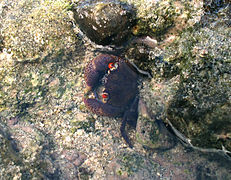Eriphioidea

Cet article est une ébauche concernant les crustacés.
Vous pouvez partager vos connaissances en l’améliorant (comment ?) selon les recommandations du projet zoologie.
Eriphioidea

Eriphia verrucosa
| Règne | Animalia |
|---|---|
| Embranchement | Arthropoda |
| Sous-embr. | Crustacea |
| Classe | Malacostraca |
| Sous-classe | Eumalacostraca |
| Super-ordre | Eucarida |
| Ordre | Decapoda |
| Sous-ordre | Pleocyemata |
| Infra-ordre | Brachyura |
Super-famille
Eriphioidea
Macleay, 1838
Macleay, 1838
Les Eriphioidea sont une super-famille de crabes. Elle comporte six familles.
Liste des familles
Selon World Register of Marine Species (27 juin 2016)[1] :
- famille Dairoididae Števčić, 2005
- famille Eriphiidae MacLeay, 1838
- famille Hypothalassiidae Karasawa & Schweitzer, 2006
- famille Menippidae Ortmann, 1893
- famille Oziidae Dana, 1851
- famille Platyxanthidae Guinot, 1977
-
 Eriphia sebana (Eriphiidae)
Eriphia sebana (Eriphiidae) - Hypothalassia armata (Hypothalassiidae)
-
 Menippe mercenaria (Menippidae)
Menippe mercenaria (Menippidae) - Ozius truncatus (Oziidae)
-
 Platyxanthus crenulatus (Platyxanthidae)
Platyxanthus crenulatus (Platyxanthidae)
Sources
- Macleay, 1838 : On the brachyurous decapod Crustacea brought from the Cape by Dr. Smith. Illustrations of the Annulosa of South Africa; being a portion of the objects of natural history chiefly collected during an expedition into the interior of South Africa, under the direction of Dr. Andrew Smith, in the years 1834, 1835. and 1836; fitted out by “The Cape of Good Hope Association for Exploring Central Africa”. p. 53–71.
- Ng, Guinot & Davie, 2008 : Systema Brachyurorum: Part I. An annotated checklist of extant brachyuran crabs of the world. Raffles Bulletin of Zoology Supplement, n. 17 p. 1–286.
- De Grave & al., 2009 : A Classification of Living and Fossil Genera of Decapod Crustaceans. Raffles Bulletin of Zoology Supplement, n. 21, p. 1-109.
Références taxinomiques
Sur les autres projets Wikimedia :
- Eriphioidea, sur Wikimedia Commons
- Eriphioidea, sur Wikispecies
- (en) Référence WoRMS : Eriphioidea MacLeay, 1838 (+ liste familles + liste genres)
- (en) Référence Paleobiology Database : Eriphioidea MacLeay 1838
- (en) Référence Catalogue of Life : Eriphioidea MacLeay, 1838 (consulté le )
- (en) Référence NCBI : Eriphioidea (taxons inclus)
Notes et références
- ↑ World Register of Marine Species, consulté le 27 juin 2016
 Portail de la carcinologie et des crustacés
Portail de la carcinologie et des crustacés  Portail de la biologie marine
Portail de la biologie marine


















